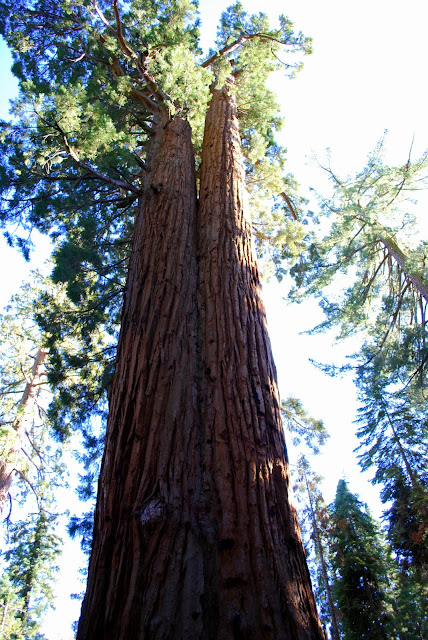In
my last post we left the awe inspiring Glacier Point in
Yosemite National Park and drove into the Wawona Tunnel. Just after exiting Wawona Tunnel and entering the valley from the south you will see one of the most famous views of Yosemite Valley called the Tunnel View.
You will see El Capitan and the Bridalveil Falls on opposite sides of the valley, and Half Dome in the distance.
Enlarge to read this historical look back in time. As always, all photos can be enlarged by clicking on them once and then again when they open on a new page.
The Bridalveil Falls is often the first waterfall visitors see when entering Yosemite Valley. In spring, it is thunderous; during the rest of the year it has a light, swaying flow.
* Please note: the spelling of "Bridalveil" as one word is not a misspelling -- it is spelled this way on the National Park Service Yosemite web site.
We hiked to the base of the falls and watched the pretty formations of water which did at time resemble a gauzy veil, as you can see in the photo collage above.
The first sight of El Capitan from the valley floor is impressive! It is a 3,000 foot high block of granite on the Northern side of Yosemite Valley, and it is the largest monolith of granite in the world.
The size of all the walls of granite peaks surrounding the valley are tremendous.
"In God's wildness lies the hope of the world." ~ John Muir
Some views of the beautiful
Ahwahnee Hotel located in the Yosemite Valley.
The hotel web site states: "The Ahwahnee shines as Yosemite National Park’s distinctive AAA® Four-Diamond hotel. Known for its magnificent façade, and architecture, The Ahwahnee was specifically designed to highlight its natural surroundings, featuring Yosemite Falls, Half Dome and Glacier Point. The destination of queens and presidents alike, The Ahwahnee offers a perfect balance of history, hospitality and elegance."
Cathedral Rocks and Spires, opposite El Capitan, form the Eastern side of the canyon through which Bridalveil Creek flows.
The Merced River is approximately 112 miles long, flowing from the Sierra Nevada into the Central Valley and San Joaquin River, which ultimately flows into the Pacific Ocean. According to the Yosemite National Park
web site:
"In 1987 the U.S. Congress designated the Merced a Wild and Scenic River to preserve its free-flowing condition and to protect and enhance the unique values that made it worthy of special protection under the Wild and Scenic Rivers Act. Both the Merced River above, through, and below Yosemite Valley, and the South Fork of the Merced above, through, and below Wawona have this special status."
A more distant view of the Bridalveil Falls.
El Capitan glowing as the late afternoon sun shines on it.
In the late afternoon the deer come down into the valley to look for fresh greenery to eat. We spotted this young doe near a trail we were walking on.
This little fellow came right up to me begging for food. Unfortunately, visitors throw snacks to some of the animals which is frowned upon. There are many signs throughout the park asking not to feed the animals as they then do not learn to scavenge their own food and suffer when winter comes and the amount of visitors decline. Also, many precautions are made to secure disposed of food in bear proof containers to prevent the bears from looking for human garbage to eat. This protects both the visitors and the bears.
A view taken from the Swinging Bridge. The famous Yosemite Falls would be visible from this point, flowing down the peaks in the distance, but as we visited in late August the waterfall was only a trickle in size as it is fed mostly by snow melt.
In my next blog post I'll show what we did see of Yosemite Falls, also Tuolumne Meadows and some magnificent views from Olmsted Point and Tioga Pass.
I'm linking this post to
Jenny Matlock's "Alphabe Thursday." The letter this week is "B" for Bridalveil Falls.
I'm also linking it to Claudia's "Friday Finding Beauty" on her blog
Dippity Road, and Sandi's "Friday Favorite Linky Party" on her blog
The Whistlestop Cafe.
Please visit all three blogs over the next two days and join in all the fun!



























































